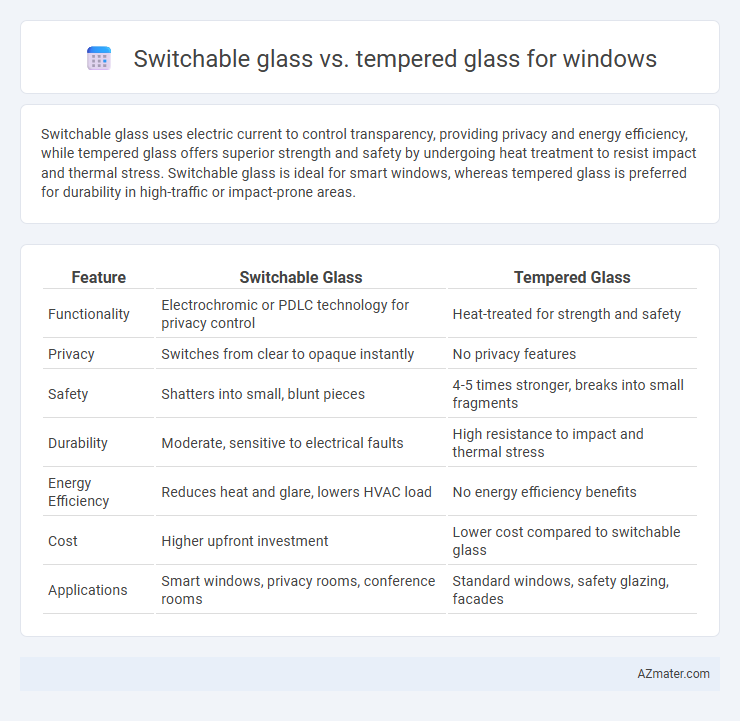Switchable glass uses electric current to control transparency, providing privacy and energy efficiency, while tempered glass offers superior strength and safety by undergoing heat treatment to resist impact and thermal stress. Switchable glass is ideal for smart windows, whereas tempered glass is preferred for durability in high-traffic or impact-prone areas.
Table of Comparison
| Feature | Switchable Glass | Tempered Glass |
|---|---|---|
| Functionality | Electrochromic or PDLC technology for privacy control | Heat-treated for strength and safety |
| Privacy | Switches from clear to opaque instantly | No privacy features |
| Safety | Shatters into small, blunt pieces | 4-5 times stronger, breaks into small fragments |
| Durability | Moderate, sensitive to electrical faults | High resistance to impact and thermal stress |
| Energy Efficiency | Reduces heat and glare, lowers HVAC load | No energy efficiency benefits |
| Cost | Higher upfront investment | Lower cost compared to switchable glass |
| Applications | Smart windows, privacy rooms, conference rooms | Standard windows, safety glazing, facades |
Introduction: Switchable Glass vs Tempered Glass
Switchable glass offers privacy and light control by changing from transparent to opaque using an electric current, making it ideal for modern smart windows. Tempered glass, known for its strength and safety, shatters into small, blunt pieces upon impact, reducing injury risk in residential and commercial windows. Choosing between switchable glass and tempered glass depends on priorities like privacy, energy efficiency, and safety requirements.
What is Switchable Glass?
Switchable glass, also known as smart glass or privacy glass, features an electrochromic or polymer-dispersed liquid crystal (PDLC) technology that allows it to switch from transparent to opaque with an electric current. This glass type provides instant privacy and UV protection while enhancing energy efficiency, making it ideal for modern window applications. Unlike tempered glass, which is heat-treated for strength and safety, switchable glass prioritizes dynamic light control and privacy over impact resistance.
What is Tempered Glass?
Tempered glass is a type of safety glass processed by controlled thermal or chemical treatments to increase its strength compared to normal glass, making it highly resistant to impact and thermal stress. It shatters into small, blunt pieces rather than sharp shards, minimizing injury risks, which is why it is commonly used in windows, doors, and automotive applications. In contrast to switchable glass, which offers privacy control through electronic modulation, tempered glass emphasizes enhanced durability and safety without any change in transparency.
Key Differences between Switchable and Tempered Glass
Switchable glass uses embedded liquid crystal technology to transition between transparent and opaque states for privacy control, whereas tempered glass is heat-treated for enhanced strength and safety. Switchable glass offers dynamic light modulation and energy efficiency, while tempered glass provides superior impact resistance and shatterproof properties. Key differences include functionality--privacy switching versus durability--and applications, with switchable glass suited for smart windows and tempered glass preferred for safety-critical installations.
Energy Efficiency Comparison
Switchable glass enhances energy efficiency by dynamically controlling solar heat gain and reducing the need for artificial lighting through its adjustable transparency, while tempered glass primarily offers thermal resistance without the ability to modulate light transmission. The electrochromic technology in switchable glass lowers HVAC energy consumption by minimizing heat transfer during peak sunlight hours, leading to significant savings compared to traditional tempered glass. Although tempered glass provides high durability and safety, switchable glass delivers superior energy performance by optimizing interior temperature and lighting conditions in real-time.
Privacy and Light Control Features
Switchable glass offers dynamic privacy by shifting from transparent to opaque with an electric current, allowing instant control over visibility and natural light flow. Tempered glass provides fixed privacy features only when frosted or treated but excels in safety and durability, resisting impact and thermal stress. For adjustable light control and privacy, switchable glass is superior, while tempered glass remains ideal for structural strength and permanent privacy solutions.
Safety and Security Aspects
Switchable glass provides enhanced privacy and controlled light transmission, contributing to safety by preventing unauthorized visibility while maintaining impact resistance. Tempered glass offers superior strength and shatter-resistance, reducing the risk of injury from breakage and improving overall security against forced entry. Both materials meet stringent safety standards, with tempered glass excelling in impact durability and switchable glass enhancing visual privacy without compromising structural integrity.
Durability and Maintenance Requirements
Switchable glass features a durable laminated structure with an electrochromic layer, providing reliable resistance to scratches and impacts but requiring occasional electrical system maintenance. Tempered glass, created through a heat-treatment process, offers superior strength and shatter resistance, making it highly durable and low-maintenance for window applications. While tempered glass demands minimal upkeep, switchable glass requires regular cleaning and inspection to ensure the electronic components and film layer remain fully functional.
Cost Analysis and Price Comparison
Switchable glass typically costs between $50 to $120 per square foot, making it significantly more expensive than tempered glass, which ranges from $10 to $30 per square foot. The higher price of switchable glass is due to its advanced technology that allows opacity control, while tempered glass offers enhanced strength and safety at a more affordable rate. For budget-sensitive projects, tempered glass provides cost-effective durability, whereas switchable glass justifies its premium price in applications requiring privacy and light control.
Choosing the Right Glass for Your Windows
Switchable glass offers dynamic privacy and energy efficiency by allowing users to control transparency with an electric current, making it ideal for modern, multifunctional spaces. Tempered glass, known for its superior strength and safety, is perfect for windows requiring impact resistance and durability. Selecting the right glass depends on balancing privacy needs, safety requirements, and energy efficiency goals for your specific window application.

Infographic: Switchable glass vs Tempered glass for Window
 azmater.com
azmater.com